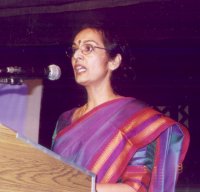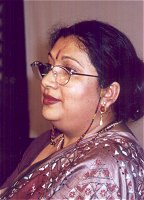Narthaki

News

Info

Featured


|
 |
MOVING MARGINS: SOUTH ASIAN DANCE IN THE UK by Naseem Khan, Chitra Sundaram, Ginnie Wollaston and Piali Ray (Natya Kala Conference 2000) Feb 2001 How the Dancers Moved the Margins: The Story of the Development of Indian Dance in the UK Its struggles and successes, the costs and benefits The changes that have taken place in Indian dance in the UK are some of the most striking developments in dance anywhere. This is a story of how a handful of dancers, unfunded and with little support mechanism, set up a movement that now commands mainstream stages in the UK. How has this come about? What were the critical success factors? How - above all - should the forms emerging from the UK be assessed and evaluated? As privileged observers from different vantage points we have watched and aided these extraordinary moves as they have unfolded. Our presentation will not just tell a story - useful though that is. It will aim also to focus on the questions that the success of the dancers raises. In the early years, the role of the dancer was comparatively simple. More often than not, in the UK on a short stay with a husband whose posting had brought him to the West, she would replicate her classical training by passing it on to a number of selected pupils. There were very few outlets for performance, and the audiences were rather small. Consequently the importance of the private concert, set up by a rasika at their home, for a few knowledgeable invited guests. Performances by such blazing dancers as Uday Shankar and Ram Gopal - served to open the eyes of Western aficionados to the body of dance existing in India. But they were regarded as exotic visitors, outreach work from a mysterious and impressive 'other' place; the dance in Britain, around the corner, competing for funding with contemporary and classical dance companies- that was a wholly different matter. In Britain, as the decades went by, so the forms and institutions moved with them. Broadly then, in the 70's the large-scale arrival of Indian families, the growing prosperity and leisure of the community and changing demographics, caused a visible upsurge in the call for cultural activities. Community-specific, culture-focused institutions, such as the Bhavan, were formed to meet this call. Following a seminal paper on 'The Arts That Britain Ignores' by the 80's, a few dancers and a handful of Asian and non-Asian votaries were seized with a vision to take 'heritage' arts beyond the immediate community and make artistic space for Indian dance in the mainstream. The development of institutions such as the Academy of Indian Arts and subsidised national tours of large-scale dance productions were the hallmarks of this decade. By the 90's, funded Dance-in-education and Community Dance (where the community is not necessarily Indian) as well as national tours for select companies became the norm. Indian dance had developed a multifaceted reflection of cultural inheritance and artistic independence and an array of professional support organisations. These are several milestones but the journey continues. All dancers in the diaspora have had to address a tendency of their new countries to place their dance in a foreign or 'ethnic' category. Maybe the audience at the Natya Kala conference should ask if this is, in fact, wrong. If the most important and visible feature of Indian classical dance is its taproot into Indian culture, history and traditions, then, of course, the Western mainstream will exclude it from its own frame of reference and always see it as 'other', wonderful as it may be. In recent times, Indian dance and dancers have had to apply new criteria and find new ideas of going about their business in order to engage with the changed environment 'The Indian communities,' said one community activist provocatively, 'Now just want to have fun....!' In other words, people who have worked hard for their prosperity, want to be able to let their hair down and enjoy the fruits of their labours; they want style, in fact, gloss and high production values rather than small obscure halls, metal-frame chairs and a leaking tea urn. However, for Indian dance, the moves out of community-controlled venues like temples, community centres and local halls brings implications in its wake. Even the million strong Asian community in the British Isles - the largest minority community - is not big enough to support full-time professional work, not even in cities like Leicester where the Asian community is predicted to be over 50% of the total population in a few years' time. Economics and need mean that dancers have to look outside the body of their own cultural support team; they have to look both to public funding and mainstream audiences. What does this process entail? What kind of strategies and devices have dancers come to use? And how far can they adapt and modify without losing the essence of the dance? These questions form another central plank in the Margins Team. We will argue that a number of patterns and paradigms co-exist simultaneously within the UK: that the richness of the dance here arises partly out of this dense layering effect. Certainly it is true that Indian dancers have taken their art form and moved it decisively out of the margins. You can find it nowadays in concert halls, school halls, festivals and residencies, in hospitals and prisons, on film and on video. The recent initiative, 'Coming of Age', staged and organised by the Akademi (founded 21 years ago by Mohiniattam dancer Tara Rajkumar, as the Academy of Indian Dance) recently took over the public face of the Royal Festival Hall, that bastion of high culture. Beginning with Mavin Khoo's small figure - hardly visible on the ledge on which he danced, dramatically jutting out seven floors high from the frontage of the Hall - the extravaganza of intense dance and music seized control of the space. Stages set along the wide terraces were used by a series of Indian dancers representing the range in the UK - professional and community, classical, contemporary and even jazz and hip hop. If anyone had entertained any doubts about the accessibility of Indian dance, then this event with its packed crowds -would have dispelled them. Dancers swarmed the riverfront, the terraces, the ledges and special ancillary stages: confident, unapologetic and impeccably drilled. And while Mavin represented the present and future, the figure of veteran dancer Pandit Ram Gopal placed at one end of the stage, showed the history and the length of the journey that had been traveled. Importantly, this journey - from 'oriental' and 'hindoo' dance to 'South Asian' dance, has brought Indian dance to a very different place and time, a different paradigm. Finally arriving at the 'mainstream', Indian dance meets its vaguely familiar childhood neighbour: contemporary British dance. Skinny and impoverished in the '70's, this 'contemporary' dance has now grown, on the same soil, into quite a formidable thing - it is now hailed as 'British Contemporary' dance, rippling with energy, challenge and performance. And around both of them, a whole world has changed - changed by technology and travel; it is now shrunken and contemporaneous in very tangible ways; it has been altered by new responses to the concept of 'home' and changing meanings of identity, nationality and community. Hypothetically, but quite close to reality, when you are of Indian origin, born in East Africa, dislocated to Britain and seriously learn Kathak and Contemporary dance and produce work with a Dutch choreographer.... What is the nationality of your piece? There is a new confidence and strength in this dislocation: the new generation had shed its 'cultural baggage' or has it? South Asian dancers and its collaborators are increasingly calling for the work to be judged by its quality as any other western dance work is. Is that a voice of a new confidence and maturity of the dance? Or is it feeding off of a new economy-driven globalised identity of the Indian/ Asian/ South Asian? And for the classicist and traditionalist, inspired by a cultural time and world apart, what is it that informs their work in the present? The panel will share some of this work and their creators' views. Over this same time, the relationship with dancers in India has also undergone change. It is one of professional exchange and not approbation. It is one of equality rather than of patronage. Choreographers and music composers create new work for presentation here and abroad and including back in India. Teachers come from India to conduct master classes and workshops and, in turn, learn new ways of teaching - across and within culture. It works because aesthetic sensibilities are widening as dance in India shifts its own margins; 'Indian' culture is no longer a monolithic construct owned by the urban, educated revivalist. It is entirely possible that a western choreographer will create a Tamil work that can successfully tour India and abroad in mainstream venues. It is not impossible to have collaborations of acknowledged Indian/ Canadian/ British/ American/ South African artists, all of Indian origin but in different worlds. In short the dancers are starting to shape a new idea - global Indian dance. If Indian dance is 'South Asian" now because it is organic in 'South Asian' countries, as it becomes third and fourth generation in non-Asian countries around the world, would we soon have to drop any geographic reference at all? It is not hard to sound positively inspirational about the UK experience. It is undoubtedly special. However, it does not make sense to be other than honest about the flashpoints and fragilities. Could these put an end to the expansion or trigger growth? While Indian dance has no doubt "contributed to the larger personality of British dance", it is too generalised to sound like anything more than a polite compliment. It is far more interesting to ask: so, is there a 'British' genre of Indian dance today and how do we recognise it? Is that a good thing to happen and is it here to stay?  NASEEM KHAN Starting her lessons from Pandit Ram Gopal, Naseem Khan went on to train in Bharatanatyam from Professor US Krishna Rao and UK Chandrabhaga Devi in their years in the UK. She and Pushkala Gopal shared the directorship of the Academy of Indian Dance in the 1980s and in 1982 she was coordinator of the alternative Festival of India. An arts journalist, her research work has covered the social impact of the arts. Naseem Khan joined the Arts Council of England in January 1996 as Senior Policy Officer. In 1999, she was awarded the OBE by the Queen for her services to Cultural Diversity.  CHITRA SUNDARAM Chitra Sundaram trained in Bharatanatyam with gurus Kalyanasundaram Pillai, Nana Kasar, Kittappa Pillai and Kalanidhi Narayanan. She has performed extensively in UK, India and Europe. An early contributor to South Asian dance in Britain, Chitra's work has been supported by Arts Council and London Arts. Chitra was an original member of Union Dance. In 1999, Chitra developed a conference on the place of Indian performing arts in the context of Singapore. She is based in London where she continues to perform and work with dance. Chitra also serves on Akademi's Board of Trustees.  GINNIE WOLLASTON Ginnie Wollaston has recently executed two productions for the Millennium Dome in London - an opera and a musical, with a cast of over 100 people in each. An M.A. in Dance Anthropology and Dance Studies from the University of Surrey, England where she focused on Asian Dance in Britain, she is a dancer, teacher, choreographer and project manager. She has covered the Olympic Arts Festival during the Olympics in Sydney for UK and Indian publications. Ms Wollaston has worked as Education Officer for Shobana Jeyasingh Dance Company, Extemporary Dance Theatre and Second Stride. Her work as producer or project manager has focused on community and education projects with opera and theatre, most recently working with the National Theatre production of Oh What a Lovely War.  PIALI RAY Since its formation in 1990, Piali Ray Mahasay has been the director of SAMPAD, the pioneering development organization for the arts of the subcontinent in the West Midlands. As dance teacher & choreographer, she has given solo as well as group performances all over UK and abroad. She has been trained in Bharatanatyam, Kuchipudi, Creative and folk styles of dance at Kalamandalam Calcutta, from Guru Venkatachalapati of Madras, the Uday Shankar India Culture Centre in Calcutta. She has produced and directed 'Dounia' a cross cultural music and dance extravaganza with South Asian, African Caribbean and European artists for Birmingham's millennium festival in 2000 and choreographed for theatre production Ramayana at Birmingham Repertory Theatre in October 2000. |